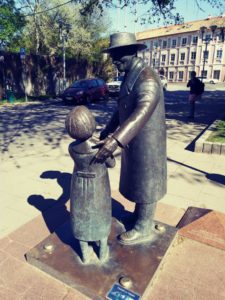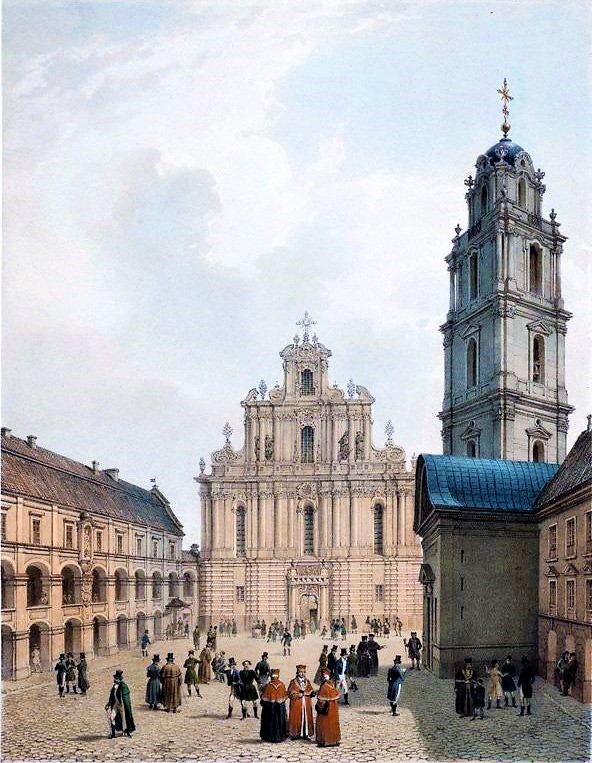The cobblestones are large and uneven. They look like a randomly strewn field of stone bobble-heads. I teeter a bit, carrying bags of Lithuanian honey, chocolate, and bubbly water back to my Bed and Breakfast. Found on Expedia, this modest, squeaky clean hotel lies in the middle of Vilnius’ extensive Old Jewish Quarter.

Despite the brilliant sunshine and cool breeze, jet lag washes over me. Maybe that’s why, just for an instant, I seem to see this leafy street as it looked in the 1930s, before the rounding up and exterminating of Vilnius’ Jews. Hitler’s insidious goal was highly successful here: the population of c. 57,000 Jews in this city known as Jerusalem of the North barely measured 2,000 by the end of World War II.
Vilnius’ Jewish Quarter was renown across Europe as a vibrant community—a prominent part of a cultured city dominated by Polish and Yiddish. I closed my eyes and tried to hear the past. I imagined myself as a Vilnius bobe (grandmother), carrying a heavy sack topped by a baguette that would teeter if I lost my footing. Only, I would not have lost my footing. My feet would know each crevice of the cobblestones, because this would have been my home.
At least until Hitler’s madmen set about in summer 1941 to empty this Jewish neighborhood and prepare it to become the Wilno Ghetto, designated for the incarceration of Lithuanian Jews. The goal was to reduce the number of Vilnius’s Jews to zero, a task accomplished first by mass exterminations (21,000), followed by street executions and subsequent starvation of the remaining population of Jews who were corralled into a ghetto stretching across these very streets. And yet even within the horrors of that ghetto, a cultural life was established, including a vibrant theater. Most of those who survived the Wilno Ghetto would later be deported to the death camps, particularly Majdanek. All of that took place here, where I now peacefully walk.

Vilnius has become my third favorite destination in Europe, after my beloved Weimar and the magical city of Krakow. Every political, religious, and cultural influence you can name has crossed through Vilnius. At one point, the Medieval Grand Duchy of Lithuania, coupled with the Kingdom of Poland, grew to be the biggest power in Europe, stretching from the Baltic Sea to the Black Sea (no small accomplishment). At another time, the late 18th century, it completely disappeared off the map, victim of the brutal partitions of Poland.
In between, Lithuania has been conquered, ravaged, revitalized, and restored so often that one gets dizzy contemplating the timeline. Yet, somehow, it survived. That gene for surviving continues to matter today as the nation entertains new threats, from depopulation (as young people en masse seek better jobs elsewhere) to nervousness about Russia’s potential land-grab ambitions.
Lithuania is arguably Europe’s most religious country, with well-attended churches everywhere, primarily Catholic but also Orthodox and some Protestant. Even more than in Poland, one feels the spirit of traditional Christianity woven into daily life. Of course, on these Smithsonian tours we treat religious sites as historical and cultural landmarks, but after hours I like to wander through Vilnius and find churches open into the evening, populated with local people praying. There’s a particularly dear single-nave Gothic church known as The Chapel of Divine Mercy where candles are always burning before a famous painting of “Christ, The Divine Mercy.” It was painted in 1934 based on the descriptions of Polish St. Faustina Kowalka who had explicit visions of Christ many times in her short life.
No matter how intense our own US history and politics may seem, we have a simple story compared to the Baltic States or Eastern Europe—for that matter, compared to almost anywhere in the world. We look back at nearly 250 years of complexities and turmoil. They look back at centuries, even millennia, of cataclysmic grievances and disasters. I don’t know how one processes that much history.
Still, it all comes down to a worn shoe crossing the cobblestones, doesn’t it? It comes down to each (today peaceful) street punctuated by the voices of children in the adjacent park. It comes down to the faith we continue to have that somehow the massive problems of humanity can, and will, be solved.
My tour begins officially in two hours with a welcome dinner. Then we spend two more days in Vilnius, continue on to Riga, then Tallinn, and end up in St. Petersburg, Russia. The lilacs are in bloom. It’s not as cold as I had feared. And so far, no one’s expectations have been left unfulfilled. It’s all good.
Still, my quiet times are what I cherish. And the moment of being pulled into Vilnius’ Jewish past will stay with me for a long while. But for now, it’s time to grab my list of guests, put on a big smile, and step forward into a job that continues to amaze me.




This is beautifully written. Thank you for such a lovely, informative post.